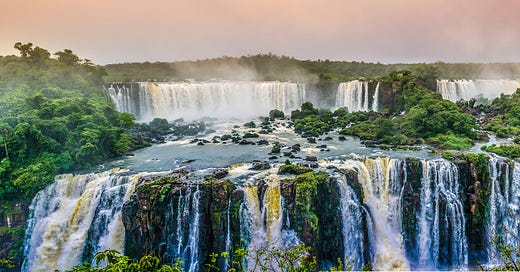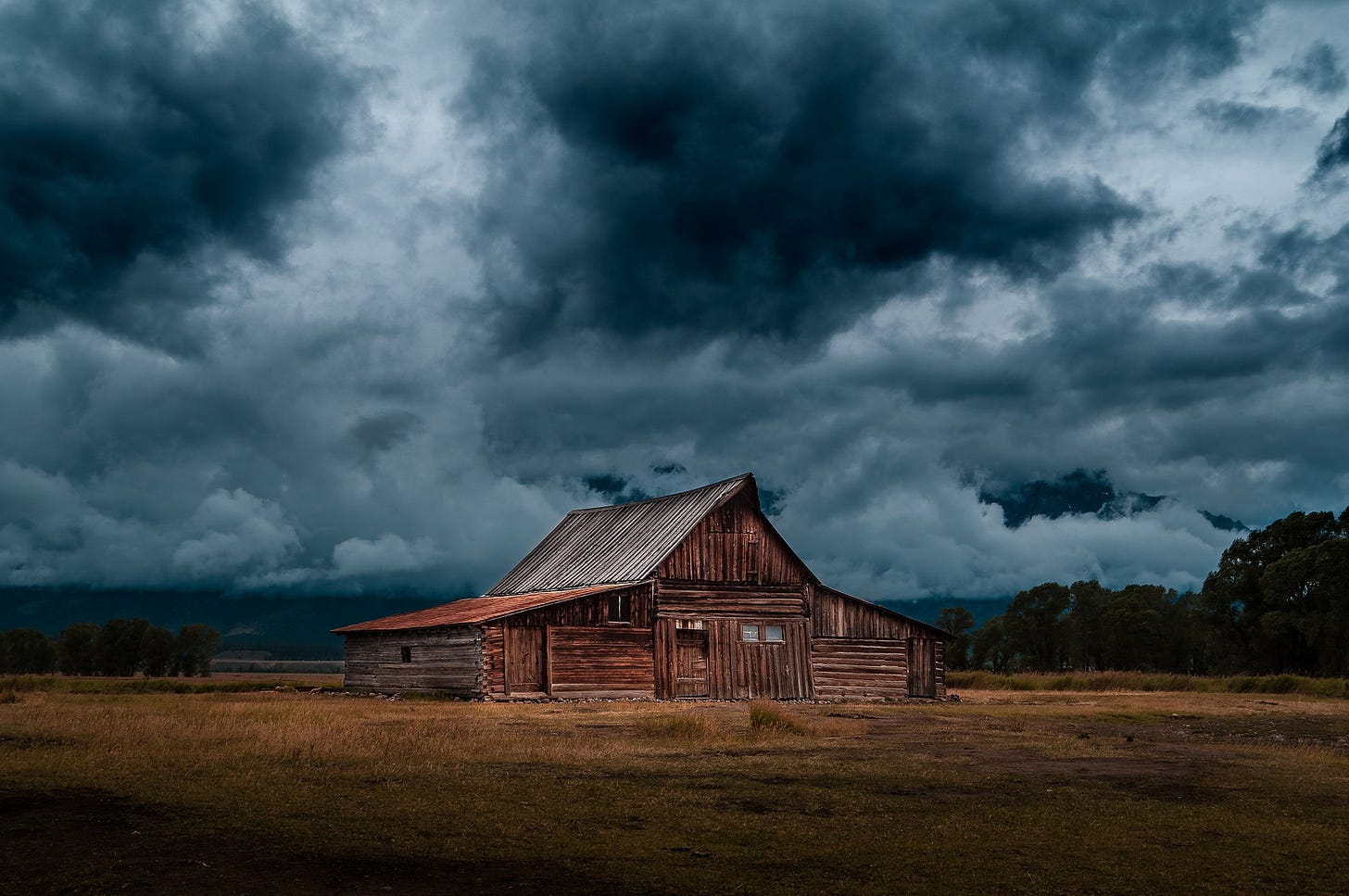Book Review: JURASSIC PARK by Michael Crichton (1990)
My Favorite Science Fiction Book of All Time!
Hello, and welcome to my blog! My name is Saadat Faiz, and I am an independent writer based in Michigan. I am the author of Iconic Animals of the North: A Fact-Filled Exploration of Northern Wildlife. To learn more about me and my work, visit my YouTube channel!
Writing book reviews is one of the best things writers can do to improve their writing skills and formulate lasting conclusions on what they’ve read. Thus, the book reviews on this website are just as much for me as they are for my readers and subscribers.
If you enjoy being connected to nature and wildlife and wish to take part in preserving the remaining biodiversity and wild places of our beautiful planet, please subscribe to this substack!
I hope that you not only enjoy reading this book review but also gain the desire to read Michael Crichton’s 1990 science fiction novel Jurassic Park yourself (if you haven’t already)! It’s a novel that shook up the world in a way few others have!
REVIEWING: JURASSIC PARK BY MICHAEL CRICHTON (1990)
NOTE: When I mention page numbers, I am referring to the mass-market paperback edition.
Steven Spielberg’s 1993 masterpiece film, Jurassic Park, was a book before it was a movie. Jurassic Park: A Novel was written by the late Michael Crichton a few years before the film’s release, and I can honestly say it is one of the best books I’ve ever read. I was utterly engrossed in the pages. Although I am a dinosaur nerd, I think people who are not as interested in prehistoric life forms will enjoy this book tremendously as well due to Michael Crichton’s extraordinary skill as a writer and uncanny ability to incorporate his breadth of scientific knowledge into his novels with incredible detail and suspenseful writing. Just read it- you will not regret it!
EXCELLENT EXPOSITION AND PERFECT PROSE
If you don’t think you have the time to read all 448 pages, I ask that you PLEASE find the time to read just the super-short introduction and prologue, because my god is it good! I bet you won’t be able to stop yourself from reading the entire novel after reading the introduction and prologue because of how immersed into this world you will be by then.
Without delay, Michael Crichton hits the reader with two quotes before the introduction starts. These quotes set an eerie tone and mood for the introduction and prologue:
“Reptiles are abhorrent because of their cold body, pale color, cartilaginous skeleton, filthy skin, fierce aspect, calculating eye, offensive smell, harsh voice, squalid habitation, and terrible venom; wherefore their Creator has not exerted his powers to make many of them.”
~ Carl Linnaeus, 1797 (Also known as the “father of modern taxonomy,” he was the Swedish Botanist who formalized binomial nomenclature)
“You cannot recall a new form of life.”
~ Erwin Chargaff, 1972 (American biochemist and writer)
The introduction describes the growing demand for the commercialization of molecular biology in this fictional world (much like what has happened in the real world!). It is revealed that in the current time of this world, scientists are increasingly becoming more and more obsessed with making a name for themselves and owning genetics companies that will make them rich. It is explained by Michael Crichton that these scientists disregard much of the likely hazards that may occur from such endeavors and are blind to see that even if certain things can be done doesn’t always mean that they should be done. Crichton says in the introduction, “Biotechnology promises the greatest revolution in human history” (Crichton, x). The genetics company, InGen, and its lofty goals are also introduced here. It is mentioned that issues are arising with this company’s projects on an offshore island in Costa Rica. InGen is not sharing what those problems exactly are with the public. The suspense builds.
Ok, so the prologue is so f%*kin’ good I can’t say enough good things about it. It’s titled PROLOGUE: THE BITE OF THE RAPTOR, and it’s the best prologue I’ve ever read because of how immersive, descriptive, believable, and spine-chilling it is. It also provides necessary background information for the overall plot and builds the setting for the story to progress.
The setting is described very well. This prologue makes readers feel as if they are in a tropical environment in the middle of a rainstorm, regardless of where they’re reading it! Readers are transported to Costa Rica and join a doctor from Chicago named Roberta Carter. She is working in a small clinic surrounded by a dense tropical jungle. I don’t want to reveal much more because I want you to experience how great this prologue is. It only takes a few minutes to read, as it is quite short. READ IT!
I will say this though- it is freaking scary! The prologue made me double-check the genre of this novel to make sure it wasn’t horror. When it comes to Jurassic Park, the book is far scarier and more violent than the 1993 film. Michael Crichton nailed the spooky vibe he was aiming for in this novel, and his suspenseful writing keeps readers curiously engaged and demanding to know what happens next. It is simultaneously disturbing and fascinating!
Overall, the exposition of this novel was constructed flawlessly, in my opinion. Right off the bat, Michael Crichton makes you feel as if you are there, in that time, witnessing the genetics revolution occur and InGen’s plans unfold. Readers can escape into a spooky world that seems so vividly real with the hot and humid weather, the eeriness, the descriptions of gore and violence, and the cold, calculative writing. It was very horror-like. The incredible amount of suspense throughout the novel prevents readers from putting it down. It’s the little things Crichton does, such as the decision to include those two quotes before the introduction (above), and to write with such a cold, descriptive, and suspenseful voice, that really help form the vibe of this super-realistic fictional world and thus, make this novel very memorable.
THE POWER OF AN IDEA
The idea itself is a big part of this novel’s success. Michael Crichton came up with a revolutionary concept and saw it through to the end; using preserved prehistoric DNA to create real dinosaurs, attempting to create a theme park filled with them, and having things go horribly wrong. When you really think about it, this is an OUTSTANDING idea for a sci-fi story. Although it seems old and cliche now, it was unprecedented when Michael Crichton thought of it.
“You know, Michael Crichton just came up with the perfect concept. I’ll tell you one conceptual line; ‘I’m writing a book about dinosaurs and DNA.’ That’s all he would say…”
~ Steven Spielberg
Steven Spielberg says the statements above at the 1:22 mark of the video below.
This video is a portion of the AMC series James Cameron’s Story of Science Fiction, in which James Cameron himself interviews some of the greatest movie directors of all time, including George Lucas, Ridley Scott, and Christopher Nolan. I highly recommend watching the entire series. Here is the link.
It is revealed in this interview that James Cameron also wanted to make a movie based on Crichton’s novel, but that Steven had already taken the job. He literally beat him to the chase! Cameron holds no grudges, however, and believes that Spielberg did a marvelous job with his 1993 film. Cameron says he would have made it an R-rated film with much more darkness and violence, which he believed would not have been as successful as Spielberg’s vision for the film.
In the novel, Michael Crichton describes in detail how the fictional bioengineering company, InGen, creates dinosaurs using DNA reconstruction in such an exhaustive and believable way that it makes readers question whether or not this could actually be done in the real world.
Michael Crichton’s idea for bringing dinosaurs back starts with an unavoidable first step- gettin’ some good ole dinosaur DNA! This DNA is acquired by the character who wishes to create a dinosaur theme park- John Hammond. Hammond finds dinosaur DNA in amber, a fossilized resin of prehistoric coniferous trees. It’s essentially extremely old hardened tree sap. The basis of the idea is that if a mosquito in the Mesozoic Era had recently sucked the blood of a dinosaur and then became stuck in the center of a glob of amber, it would contain the DNA of that dinosaur in its stomach. That DNA would be preserved along with the entire mosquito for a long time. Thus, Hammond utilizes his vast financial wealth to acquire as much amber as he possibly can from all corners of Earth in an attempt to find these preserved prehistoric mosquitos containing dinosaur DNA. Once his employees acquire a block of amber with a mosquito inside, they send it on to the InGen labs, where trained scientists safely extract the DNA and use extremely powerful (and expensive) computers to understand how to complete the DNA sequence with the DNA of existing animals to eventually create LIVING… BREATHING… DINOSAURS.
Tell me that doesn’t sound believable! I think it’s a remarkable idea for a science fiction novel. Jurassic Park by Michael Crichton has influenced human culture on a global scale because of the brilliance of this idea. Obviously, workable DNA can’t be preserved for tens of millions of years (or can it?), but that is where the beauty of science fiction lies. The contemplation of what ifs, different ways of looking at scientific concepts, and sometimes even direct application of methods and discoveries in the real world.
WHAT DIDN’T WORK
This thrilling science fiction novel did not have any major flaws, in my opinion, so I will just go over two things that I think could have been better.
At the beginning of the novel, the repeated hinting (towards the reader and certain characters) at the possibility of live dinosaurs being involved in InGen’s project was too prolonged and became a bit repetitive (it was driving me crazy at one point, lol). However, I think this is what the author was going for to build suspense until the dinosaurs were revealed to the characters. Michael Crichton wanted to let the audience know something the characters did not. Numerous trivial things occurred that prevented characters such as Alan Grant and Ellie Sattler from obtaining knowledge of what was really going on with Hammond’s project. The suspense ballooned to a considerable size before the main characters realized that there were indeed live dinosaurs on the island.
I also think that if the audience could form a stronger sense of attachment to the characters, it would have made them feel more involved in the latter half of the plot when all the characters’ lives were at stake. Michael Crichton could have dove deeper into each of the primary characters in a way that would make the audience really connect with them and care for their well-being on the insanely dangerous island of Isla Nublar.
It is revealed in TIME Special Edition: The Story of Jurassic Park (2022) that Michael Crichton had a hard time diving into his characters’ motivations. For many years, he wasn’t interested in his characters, as he was more concerned about possibilities and situations. He was mainly interested in issues that arise, whether they grow out of science, out of society, or out of what is happening to us.
AN INCREDIBLE CAST OF CHARACTERS
I don’t know how the hell Michael Crichton created these characters. All I can say is he did a damn good job at it. Although he could have expanded the individual motivations of his characters further, the different types of characters in this novel are utterly perfect for the concept and progression of the plot. You got a greedy, selfish, rich, insane businessman in John Hammond, a brilliant, out-of-the-box thinking mathematician with a unique sense of charm and humor in Ian Malcolm, A world-renowned paleontologist who is a simple man in love with what he does in Alan Grant, two innocent kids in Tim and Lex (Hammond’s grandchildren), a beautiful and intelligent lady who is also Alan Grant’s student in Ellie Sattler, a Bear-Grylls-type wild animal expert and game warden in Robert Muldoon, a cowardly, money-hungry lawyer in Gennaro, a selfish software engineer looking for shortcuts in life in Dennis Nedry, a head engineer who is convinced he can control the technical side of Jurassic Park all by himself in John Arnold, and a brilliant scientist looking to make a name for himself in Henry Wu.
This motley crew mixed really well to move the plot forward in interesting, unpredictable, and thrilling ways. My favorite character is Ian Malcolm. Michael Crichton made a great decision to create and include a mathematician specializing in the fictional “chaos theory” in this plot. In the novel, chaos theory is a new scientific theory in an emerging branch of mathematics that focuses on underlying patterns in complex systems. Ian Malcolm specializes in it. It’s used to find answers to things that cannot be calculated with simple math, such as the weather (to this day, weather is impossible to predict with 100% accuracy). Chaos theory provides guidance in predicting outcomes in situations that have many rapidly changing factors and variables. Chaos theory led Ian Malcolm to believe with utmost certainty that Jurassic Park was doomed from the start. Essentially, he believed that there were way too many paths for things to go wrong, and so they inevitably would go wrong. He tries to convince John Hammond of this throughout the novel. Malcolm was heavily against the entire biotechnology revolution and the constant scientific discovery that was going on at the time.
Hammond, on the other hand, is a very self-centered, greedy, business-minded, and delirious character. He essentially wishes to create a theme park so revolutionary that it can compete with the likes of Disney World and make him tons of cash. He is ignorant of much of the science involved in this massive endeavor. Hammond proceeds to acquire a remote island near the western shores of Costa Rica (the movies were filmed in Hawaii, not Costa Rica) known as Isla Nublar. He then hires construction companies, scientists, lawyers, and many uneducated workers (to avoid paying them what they deserve and maximize his profits) from Costa Rica to do much of the physical labor. During the early stages of the creation of Jurassic Park, many of these underpaid workers were injured and killed by the dinosaurs. Hammond was skilled at influencing just about anyone to help him bring his vision to reality. Well, everyone other than the eccentric Ian Malcolm.
All in all, these characters were created brilliantly. Some complimented each other, while others clashed with one another. Each character fits like a puzzle piece into the dynamic of the story to make it as thrilling, unpredictable, and spectacular as possible.
BOOK VS. MOVIE
I could talk for hours about the many qualities of the 1993 film, Jurassic Park, that made it one of the heaviest-hitting box office movies of all time. However, since this is a book review and not a movie review, I’ll keep it relatively brief.
Stephen Spielberg nailed it! The movie could not have been any better with the PG-13 rating that it was given. The audience was still morbidly terrified at many scenes throughout the film, and when the action kicked in, boy did it come strong! Audiences felt as if they were physically WITH the characters screaming for their lives! It felt more like a roller coaster ride than a movie! In 1993, millions of people left theaters feeling absolutely bewildered with amazement at what they had just experienced. This movie set the bar astronomically high in terms of giving the audience a thrilling experience mixed with fear, wonder, and amazement.
At the time, there had never been such excellent usage of CGI and animatronics. The dinosaurs looked 100% real in many scenes. The Tyrannosaur scenes alone were a unique blend of thrilling, terrifying, and fascinating all at once in a way that had never been seen before. The raw power of the mightiest predator to ever roam the Earth was on full display. The velociraptor scenes were even scarier! Although velociraptors in reality were never as large as the ones in the film (and the book), the decision to increase their size for a science fiction plot was a great one. Characters could now get killed in the blink of an eye by one of these intelligent beasts. It was a terrifyingly thrilling experience for readers and watchers.
In my opinion, Michael Crichton’s plot, creatures, and characters were able to shine brightly in the film. It is quite a tough job to convert a book into a film. Usually, many things have to be omitted from the book to fit into the time duration of the film. Shifts in medium are challenging to get right. Even though many things had to be taken out, I do not see how the film could have been much better in any way, shape, or form. It is a masterpiece of human cinema and art and a big part of my childhood. Thank you, Michael Crichton, Stephen Spielberg, David Koepp, all the actors/actresses, and honestly anyone who had any role in the creation of this world-changing movie!
THE IMPORTANCE OF HAVING REAL SCIENTIFIC KNOWLEDGE WHEN WRITING SCIENCE FICTION
Michael Crichton’s work truly shows the importance of having actual scientific knowledge when writing science fiction novels. When things are more believable, they cause readers’ gears to turn. It keeps readers engaged while reading the book and still wondering about it when they’re not reading the book.
It helps to be a Harvard graduate when writing a science fiction novel! Michael Crichton graduated from Harvard University and Harvard Medical School in the 1960s but never went on to become a doctor. He loved writing science fiction novels, so that is what he continued to do! It’s actually mind-boggling when you realize that many of Crichton’s in-depth explanations of how dinosaur DNA was acquired, how these creatures were created using DNA from the past and modern gene technology, why the dinosaurs behaved and functioned the way they did, the state and culture of the scientific community, how the powerful computers made calculations based on the billions of factors involved in DNA modification, and how the technological systems that handled park security worked (down to the actual lines of code!) were for the most part scientifically accurate! Michael Crichton was a very smart guy.
He has said that the fast-paced narrative style of his novels was a product of his time in the medical emergency room, where things happen fast!
“Any sense of narrative pacing on my part comes out of the emergency room.”
~ Michael Crichton, TIME Special Edition: The Story of Jurassic Park (2022)
Now don’t let this deter you from writing science fiction- you don’t need to be a Harvard graduate. You just need to have the passion and interest to learn about the fields of science that are heavily intertwined in your science fiction story. Watch tons of documentaries, read tons of books, and have fun while doing so! Learn what you need to know to make your story as believable as possible if that is your goal. Not saying that soft science fiction is bad or anything; I’m simply just a huge fan of hard science fiction. I recently read The Martian by Andy Weir for the first time, and I loved it (that’s saying a lot because I’m someone who is not interested in different planets and space travel. My obsessions currently remain on Earth, by far the most fascinating planet we know of, with all its interconnected biomes, life forms, and natural history).
As discussed in the TIME Special Edition: The Story of Jurassic Park, Michael Crichton produced some of his best work as a writer at the perfect time:
“Crichton hit his stride as a writer at the perfect time- Neil Armstrong had just walked on the moon, and the unimaginable seemed possible, even inevitable. The capabilities and presence of computers increased exponentially, and they became the tool of choice for human ambition. So did public mistrust of foibles that could lead such a potent combination astray- greed, pride, and pursuit of power.”
~ TIME Special Edition: The Story of Jurassic Park
From a business standpoint- Michael Crichton was able to see that morality-based, soul-searching stuff could exist with classic, crowd-pleasing stuff in a fiction film during that time. When assessing the quality and success of the novel and the movie, I think it’s fair to say that he was spot on!
PRIMORDIAL FUTURE, MY NEXT BOOK(s)!
The previous quote (“Crichton hit his stride as a writer…”) makes me wonder about the relevance of the idea for my next book that I am currently working on; PRIMAL FUTURE. This will be a dystopian science fiction epic that takes place on Earth, hundreds of years in the future, after a massive war between androids and humans. Androids deemed humans to be too destructive to the planet for their own good and waged war upon them. As the androids shed the blood of their creators, they were fulfilling their base function; to protect the human race. Just prior to this war, global greenhouse gas content, land and water pollution, mental plagues, food and water shortages, and erratic weather patterns had increased so drastically throughout the ravaged planet that the man-made androids calculated the only way left to save the human race from themselves was to eradicate the vast majority of the human population and restart human society on a regenerated Earth, controlled and monitored by them.
In this universe, the natural world has reclaimed much of Earth. The buildings and skyscrapers of cities that were once sprawling and filled with citizens are crumbling apart, with plants draping out of their crevices and creatures sheltering within them. All the biomes and natural areas of Earth are cleaner, larger, and wilder, with thousands of once-endangered creatures (many of them potentially dangerous) having repopulated the Earth. The world has returned to a state similar to what John James Audobon saw when he traveled west on the steam vessel Omega to observe wildlife. Audobon wrote in his journal: “In fact, it is impossible to describe or even conceive the vast multitudes of these animals that exist even now, and feed on these ocean-like prairies” (This quote was mentioned in the book, American Serengeti: The Last Big Animals of the Great Plains, by Dan Flores).
The only functional cities left on Earth are those run by androids. Intelligent machines. There is a small human population left on Earth. However, these humans are subordinate to their own sentient creations.
Although I think this concept is very relevant to the modern public in many ways, that isn’t why I’m writing it. I’m writing it because I am obsessed with it, I love the act of creating it so much that I find myself reading, researching, writing, and taking notes obsessively for hours on end.
STAY TUNED FOR MY FIRST SHORT STORY!
Technically this won’t be my first story since I wrote a short story when I was about ten years old in Warren, MI, with the X-men, Wolverine, as the protagonist. Now, 14 years later, I am working on another short story that takes place in the world of PRIMORDIAL FUTURE (which I am still building). I plan to upload it onto this substack as soon as it is finished. Please subscribe to be notified when it is out!
Even with androids ruling over humanity and whatnot, I still want this to be as hard a science fiction story as I can possibly make it. This needs to be realistic. That is why I am currently reading books on world-building, plot and character construction, ecology, sustainable food production, wilderness exploration, self-sufficiency in the outdoors, the potential of artificial intelligence, and human history in a broad context (the revolutions that have occurred, and what potential revolutions the future may bring). I am even researching things like cabin construction to make the finer details of my fictional world as accurate as possible. I have certain characters in my science fiction universe living in cabins far out on Earth’s natural lands. I plan to write about that kind of lifestyle with accuracy. Also, almost all humans in this universe are under the watch and control of the AI android syndicate. Thus, I will be diving into Isaac Asimov’s books for inspiration on how to create my android societies in the universe of PRIMORDIAL FUTURE.
Oh, and by the way- I need help making a decision. What sounds best? PRIMORDIAL FUTURE, PRIMAL FUTURE, or just PRIMORDIAL? I initially came up with the concept of this universe a few months ago. I was calling it PRIMORDIAL FUTURE in my head. I really like that title, but the problem is, I think it may be a bit too long of a title with too many syllables, which is why I want to shorten it to PRIMAL FUTURE. Anyways, let me know what you think!
Stay tuned for the release of my first short story starring 21-year-old protagonist, Ellie Soojin, as she travels through the American heartlands on an electric motorcycle to complete a dangerous assignment involving some of the fiercest predators on Earth.
CONCLUSION
All in all, I was simply blown away by Jurassic Park by Michael Crichton. It is one of the top ten best books I’ve ever read, and it’s by far the best science fiction book I’ve read in my life thus far. I look forward to reading the sequel to Jurassic Park; The Lost World (1995). I’ve been told it is much better than the movie. Not that I disliked the movie!
In the meantime, I will be plowing through my reading list and watching author interviews (and straight-up courses) on YouTube (most of them are George R. R. Martin and Brandon Sanderson videos. GRRM is so down-to-Earth, generous with his knowledge, and great at what he does! And Brandon Sanderson is wonderful for providing so much of his teachings available to the public), so I can upload more book reviews and complete my first short story for you guys! Have a great rest of your week, and keep on readin’ great books!
If you read the entire article, I’d like to sincerely thank you. Please feel free to leave a comment below and subscribe for future articles!








